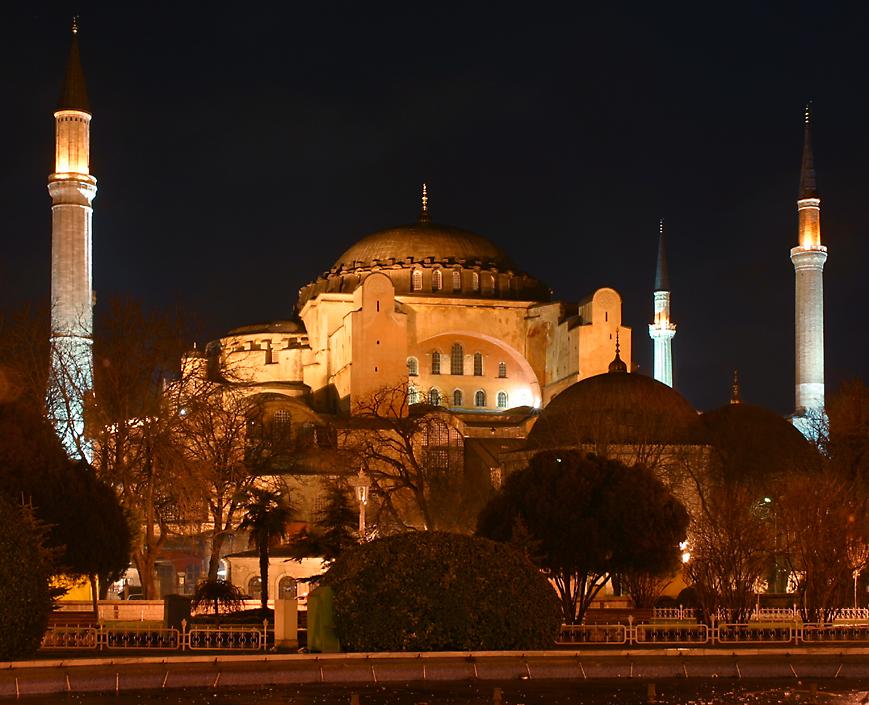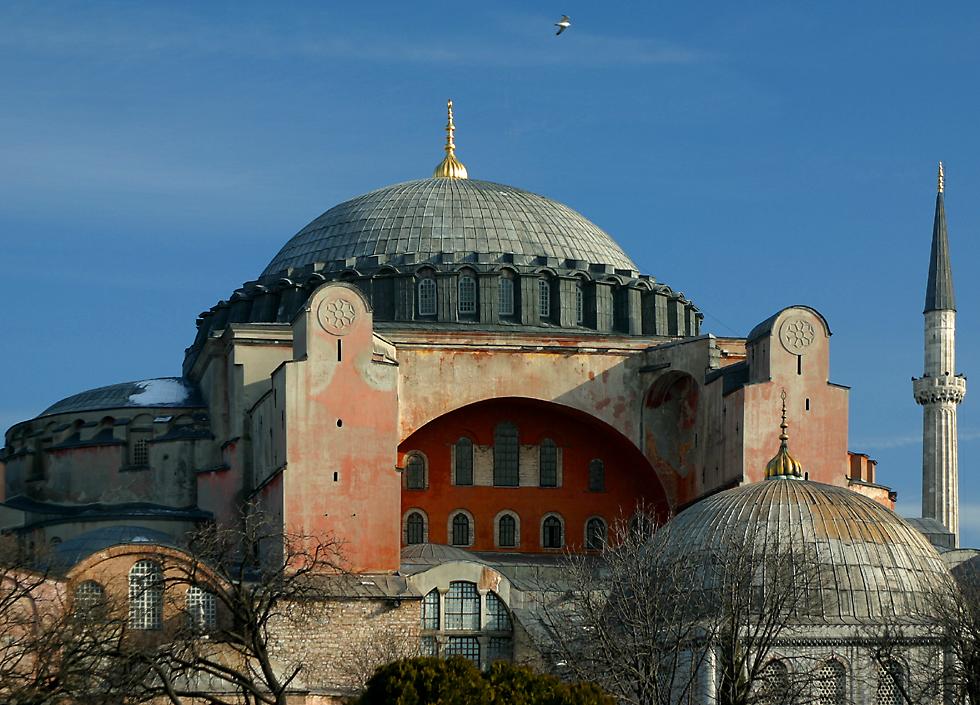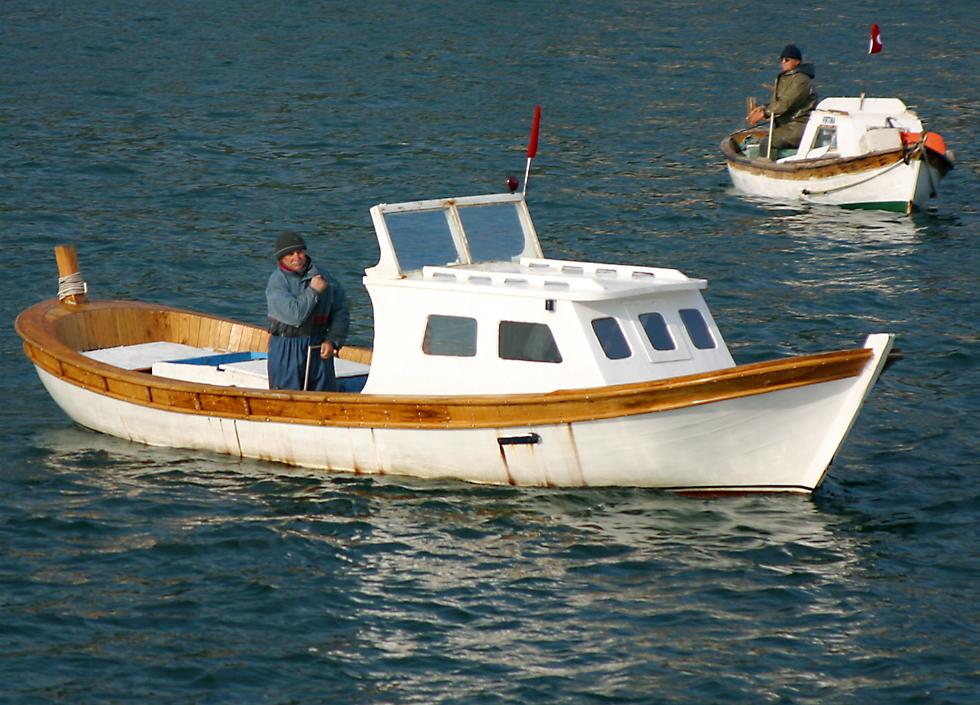Highlights of Istanbul
|
In December of 2004 I made a two or three day stopover in the Turkish city of Istanbul while on my way to Egypt. At the top of my list of sights to see in Istanbul was this place, known as Hagia Sofia in Greek, Sancta Sophia in Latin, the Church of the Divine Wisdom in English and now Aya Sofia in Turkish. |
 |
|
It's not a bad sight when lit up at night-time, even though it's had many additions made to its exterior, the most obvious of which are the four tall minarets which now surround it. |

|

The main dome is an incredible achievement, but it wasn't done without difficulties, in fact the first dome collapsed during an earthquake only eleven years after it was constructed, and the second only lasted another five years. It had to be reconstructed several times over the following centuries, and more buttressing added to the outside to provide extra strength. In a way, the history of Aya Sofia is a small-scale reflection of Istanbul itself, which has gone through as many changes of name as the cathedral. The city was originally settled in 667 BC by Greeks who named it Byzantion after King Byzas; it was besieged by pagan Roman emperor Septimius Severus in AD 196, who rebuilt it and Latinized its name to Byzantium. In AD 330 emperor Constantine refounded it, named it Constantinople after himself, and moved the capital of the Roman Empire from Rome to Constantinople. When the empire broke into two parts, Constantinople became the capital of the eastern, Byzantine Empire. In 1453 the Byzantine empire was overthrown by muslim armies, and Constantinople became Constantiniyye the capital of the Ottoman Empire, making this the only city in the world which has been the capital of three different empires. After the conquest Hagia Sophia became Aya Sofia and was turned into a mosque, which it remained until the statesman Ataturk disbanded the Ottoman sultanate, proclaimed the Turkish Republic with its capital at Ankara, renamed Constantiniyye to Istanbul and turned Aya Sofia into a museum. Today you can still see remnants of both its Christian and its Muslim periods, the latter represented by the large discs with the name of Allah and some of the sultans, a muslim pulpit with steps called a mimber, and the mihrab beyond the chandelier which shows the direction to Mecca. |
|
Here's that mihrab, surrounded by text from the Koran both in stained glass and classic blue tiles, which are used in many middle eastern mosques. |
 |
|
Here's Jesus with John the Baptist. Look closely and you'll see the individual tiles which make up these mosaics; 30 million tiny gold tiles were used to line the main dome itself. |
 |

I think of this mosiac as Christ and His Opposable Thumb. Whatever the mosaic's precise meaning, it's clear that Jesus thinks that Emperor Constantine IX and Empress Zoe are A-OK, and he wants to publicly express his gratitude to them for providing all of those bags of money so he could have a comfy throne, a nice cushion, a good book to read and 30 million tiny gold tiles to make the place look nice. |
|
Like Aya Sofia, it's also lit up at night and in the warmer months there's a nightly sound-and-light show. |
 |

I really regret not having spent much time in Istanbul, because not only didn't I have time to see the inside of the Blue Mosque, I also missed seeing many of its other most interesting sights. For instance, the Gate of Salutations here is about as close as I got to viewing the legendary Topkapi Palace, home of the Ottoman sultans for the first 400 years of their reign. Even worse in my opinion, I somehow failed to visit the Hippodrome, which is right beside the Blue Mosque. This was the center of the pagan Roman city, even today it includes obelisks and columns looted from Egypt and ancient Greece. And while I did pass the entrance to the Roman underground water cisterns, I didn't find time to tour them, either. |

The mosque of Suleyman the Magnificent is the largest in Istanbul and the grandest in all of Turkey. It was built between 1550 and 1557 by sultan Suleyman I, and his tomb is just outside the mosque, near the tomb of his ambitious and powerful wife Roxelana. Suleyman's death in 1566 began the period known as the Rule of the Women, with weak sultans being encouraged to indulge in the pleasures of the flesh while their mothers and grandmothers indulged in political intrigue and scheming. The expansion of the empire was only achieved by the efforts of the viziers and other officials who did the day-to-day running of the empire. |

And here's the Galata Tower, the highest point of a citadel built by traders from the Italian city of Genoa. Standing 67 meters high, it was the tallest building in the city. When it was built in 1348 it was called The Tower of Christ and it controlled a giant metal chain which was placed across the Golden Horn to prevent muslim invaders from bringing ships into the waterway. Amazingly, some of the links from this chain are on display at Istanbul's military museum, though they didn't really help the city, since the invaders transported their boats overland at night and stormed in the next morning. While I was waiting to catch my flight back to the United States I read of another claim to fame which the Galata Tower has, as the launching place for a very early manned heavier-than-air flight! It's claimed that in 1638 Hezarfen Ahmet Çelebi climbed the tower, strapped on a pair of wings and successfully flew across the Bosporus. Çelebi is still revered in Turkey, one of Istanbul's three airports is even named after him. |
|
You can see from the surrounding houses and the vehicles on the street just how large the walls and towers of the fortress are. |
 |
|
Nearby is the northernmost of two giant suspension bridges across the Bosporus, this one is called the Fatih bridge. |
 |
|
The Bosporus still has a lot of strategic importance, with a great deal of oil and other shipping coming down from Russia and other Black Sea countries. |
 |

Until that day, a trip on the Bosporus is also a good way to see some of the area's birdlife. |
|
Istanbul has always been a very good place to get a nice shag. |
 |

On the trip back to the city you can see many luxurious houses called yali along the banks of the Bosporus. It looks like it would be one heck of a big job for the maids to wash all of those wooden louvres! |











